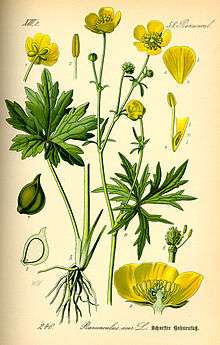Ranunculus acris
| Ranunculus acris | |
|---|---|
 | |
| Scientific classification | |
| Kingdom: | Plantae |
| Clade: | Angiosperms |
| Clade: | Eudicots |
| Order: | Ranunculales |
| Family: | Ranunculaceae |
| Genus: | Ranunculus |
| Species: | R. acris |
| Binomial name | |
| Ranunculus acris | |
| Synonyms | |
| |
Ranunculus acris is a species of flowering plant in the family Ranunculaceae, and is one of the more common buttercups across Europe and temperate Eurasia. Common names include meadow buttercup,[1] tall buttercup,[2] common buttercup and giant buttercup.
Description
Ranunculus acris is a herbaceous perennial plant that grows to a height of 30 - 70 cm, with ungrooved flowing stems bearing glossy yellow flowers about 25 mm across. There are five overlapping petals borne above five green sepals that soon turn yellow as the flower matures. It has numerous stamens inserted below the ovary. The leaves are compound, with three lobed leaflets. Unlike Ranunculus repens, the terminal leaflet is sessile. As with other members of the genus, the numerous seeds are borne as achenes. This and other buttercups contain ranunculin, which breaks down to the toxin protoanemonin, a chemical that can cause dermatitis and vomiting.
The rare autumn buttercup (R. aestivalis) is sometimes treated as a variety of this species.[3]
Distribution
The plant is an introduced species across much of the world. It is a naturalized species and often a weed in parts of North America,[4] but it is probably native in Alaska and Greenland.[5] In New Zealand it is a serious pasture weed costing the dairy industry hundreds of millions of dollars.[6] It has become one of the few pasture weeds that has developed a resistance to herbicides.[7]
Cultivation
In horticulture the species may be regarded as a troublesome weed, colonising lawns and paths. However, it may be a welcome feature of wildflower meadows. The double-flowered cultivar R. acris 'Flore Pleno' has gained the Royal Horticultural Society's Award of Garden Merit.[8][9]
Uses by Native Americans
The Abenaki smash the flowers and leaves and sniff them for headaches.[10] The Bella Coola apply a poultice of pounded roots to boils.[11] The Micmac use the leaves for headaches.[12] The Montagnais inhale the crushed leaves for headaches.[13]
The Cherokee use it as a poultice for abscesses, use an infusion for oral thrush, and use the juice as a sedative.[14] They also cook the leaves and eat them as greens.[14]
The Iroquois apply a poultice of the smashed plant to the chest for pains and for colds, take an infusion of the roots for diarrhea,[15] and apply a poultice of plant fragments with another plant to the skin for excess water in the blood.[16]
References
- ↑ "BSBI List 2007". Botanical Society of Britain and Ireland. Archived from the original (xls) on 2015-01-25. Retrieved 2014-10-17.
- ↑ "Ranunculus acris". Natural Resources Conservation Service PLANTS Database. USDA. Retrieved 18 October 2015.
- ↑ USDA Plants Profile: R. aestivalis.
- ↑ Invasive Weeds of King County, Washington
- ↑ Flora of North America
- ↑ Bourdôt, GW; Saville DJ (2010-08-31). "Giant buttercup - a threat to sustainable dairy farming in New Zealand". Proceedings of the Australasian Dairy Science Symposium: 355–359.
- ↑ Cronshaw, Tim (18 May 2012). "Profit-strangling weed immune to hebicides". The Press.
- ↑ "RHS Plant Selector - Ranunculus acris 'Flore Pleno'". Retrieved 30 May 2013.
- ↑ "AGM Plants - Ornamental" (PDF). Royal Horticultural Society. July 2017. p. 84. Retrieved 23 September 2018.
- ↑ Rousseau, Jacques 1947 Ethnobotanique Abenakise. Archives de Folklore 11:145-182 (p. 166)
- ↑ Smith, Harlan I. 1929 Materia Medica of the Bella Coola and Neighboring Tribes of British Columbia. National Museum of Canada Bulletin 56:47-68 (p. 57)
- ↑ Chandler, R. Frank, Lois Freeman and Shirley N. Hooper 1979 Herbal Remedies of the Maritime Indians. Journal of Ethnopharmacology 1:49-68 (p. 60)
- ↑ Speck, Frank G. 1917 Medicine Practices of the Northeastern Algonquians. Proceedings of the 19th International Congress of Americanists Pp. 303-321 (p. 315)
- 1 2 Hamel, Paul B. and Mary U. Chiltoskey 1975 Cherokee Plants and Their Uses -- A 400 Year History. Sylva, N.C. Herald Publishing Co. (p. 31)
- ↑ Herrick, James William 1977 Iroquois Medical Botany. State University of New York, Albany, PhD Thesis (p. 320)
- ↑ Rousseau, Jacques 1945 Le Folklore Botanique De Caughnawaga. Contributions de l'Institut botanique l'Universite de Montreal 55:7-72 (p. 42)
External links
| Wikimedia Commons has media related to Ranunculus acris. |
| Wikispecies has information related to Ranunculus acris |